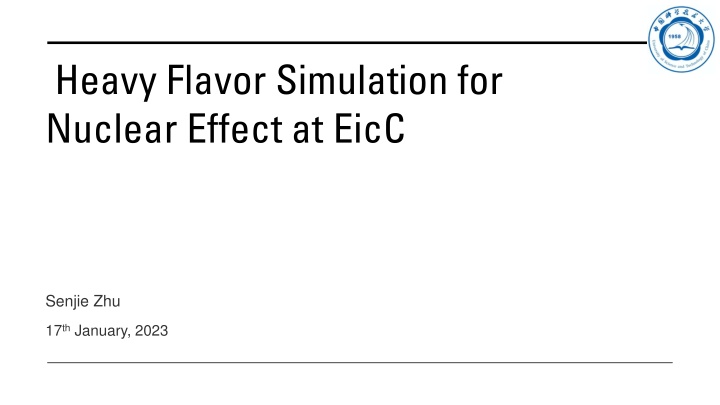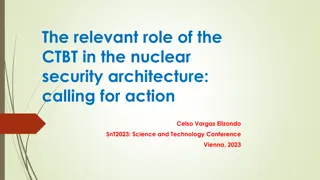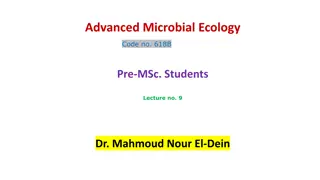Heavy Flavor Simulation for Nuclear Effect at EicC by Senjie Zhu
Fragmentation and hadronization differences in heavy flavor mesons compared to light mesons due to their stronger interaction with nuclear matter are explored in this study. The use of inclusive measurements at EicC is expected to provide insights into initial and final state effects in heavy ion collisions. The simulation setup, detector geometry, and performance are detailed, including the detector parameters, vertex smearing process, event generation, and reconstruction with applied cuts.
Download Presentation

Please find below an Image/Link to download the presentation.
The content on the website is provided AS IS for your information and personal use only. It may not be sold, licensed, or shared on other websites without obtaining consent from the author.If you encounter any issues during the download, it is possible that the publisher has removed the file from their server.
You are allowed to download the files provided on this website for personal or commercial use, subject to the condition that they are used lawfully. All files are the property of their respective owners.
The content on the website is provided AS IS for your information and personal use only. It may not be sold, licensed, or shared on other websites without obtaining consent from the author.
E N D
Presentation Transcript
Heavy Flavor Simulation for Nuclear Effect at EicC Senjie Zhu 17thJanuary, 2023
Motivation Fragmentation and hadronization can be very different in different system. Because of the shorter formation time of heavy flavor mesons, they have stronger interaction with nuclear matter than light mesons. In heavy ion collisions, the picture is even more complicated, indeed initial and final state effects are entangled. The main initial state effect, in nuclear lepton scattering, is the EMC effect. It can be canceled with inclusive measurements. Their measurement at the EIC is expected to avoid most of the heavy-ion background subtraction challenges due to the much cleaner DIS environment. 2
Simulation Setup Detector Geometry Geant4 Simulation Detector Performance Events from Generators Physics Projections 3
Detectors Front. Phys. 16, 64701 (2021) ITS3, pixel size 10 ?? ? < 3.5 p-going Barrel e-going Silicon 5 5 5 MPGD 1 4 0 Tracking Detectors & Vertex Detectors Latest resolutions applied: https://gitee.com/aiqiang- guo/EicC_Mvd_DP 4
Detector Parameters ??[??] eID Acceptance(3 ? ??????????) ??> 0.35???/?,??< 20???/? PID Acceptance (?\K\p) (3 ? ??????????) [ 3.5,1] ( 1,1] 1,3.5 ? 4 ??? 6 ??? 15 ??? ???? ? ?????> 0.3???/? 5
Vertex Smearing Process X X X At X-Y plane, find the closest point to z-axis to calculate DcaXY(Det) and use the DcaXY resolution to smear DcaXY(Det) Use the z coordinate of the point above as DcaZ(Det) and smear it DcaZ(Det) 6
Event Generator pythiaeRHIC: ? 3.5 ??? ? 20 ???????= 8.064 ?? 1 EicC run for 2 months DIS cut: ?2> 2???/ ?2, ?2> 4???2, 0.05 < ? < 0.8 PID Acceptance (?\K\p) (3 ? ??????????) [ 3.5,1] ( 1,1] 1,3.5 ? 4 ??? 6 ??? 15 ??? ???? ? ?????> 0.3???/? 7
Reconstruction ?+ ? ?0 ??????????? ??? ????? ?????????? ?? cos??? ?0 8
Reconstruction Applied Cut ?????< 110 ?? ??????> 0.75 ?????????? ?? Cut scanning is recursively from left to right. ?0> 35 ?? 9
?0 ?????????????? no PID: all combination between opposite charge particles with PID: perfect PID at acceptance and abandoned out of acceptance Vertex: topological cut applied to suppress background 10
?0Double Ratio ep data is applied to both ep system and eA system. Higher efficiency can be achieved at high z. Corresponding to significance distribution, the errors of double ratio at high z are lower than those at low z. 12
Baryon-to-meson Ratio Patron fragmentation varies with different system. Data is produced by pythia8 and two fragmentation model (QCD-CR and MPI- CR)are used. 13
Conclusions Basic structures of track & vertex detectors are proposed and are being optimizing. With the performance of the detector we have simulated, we have projected errors of some physics observables. Double Ratio of ?0 Baryon-to-meson Ratio 14























